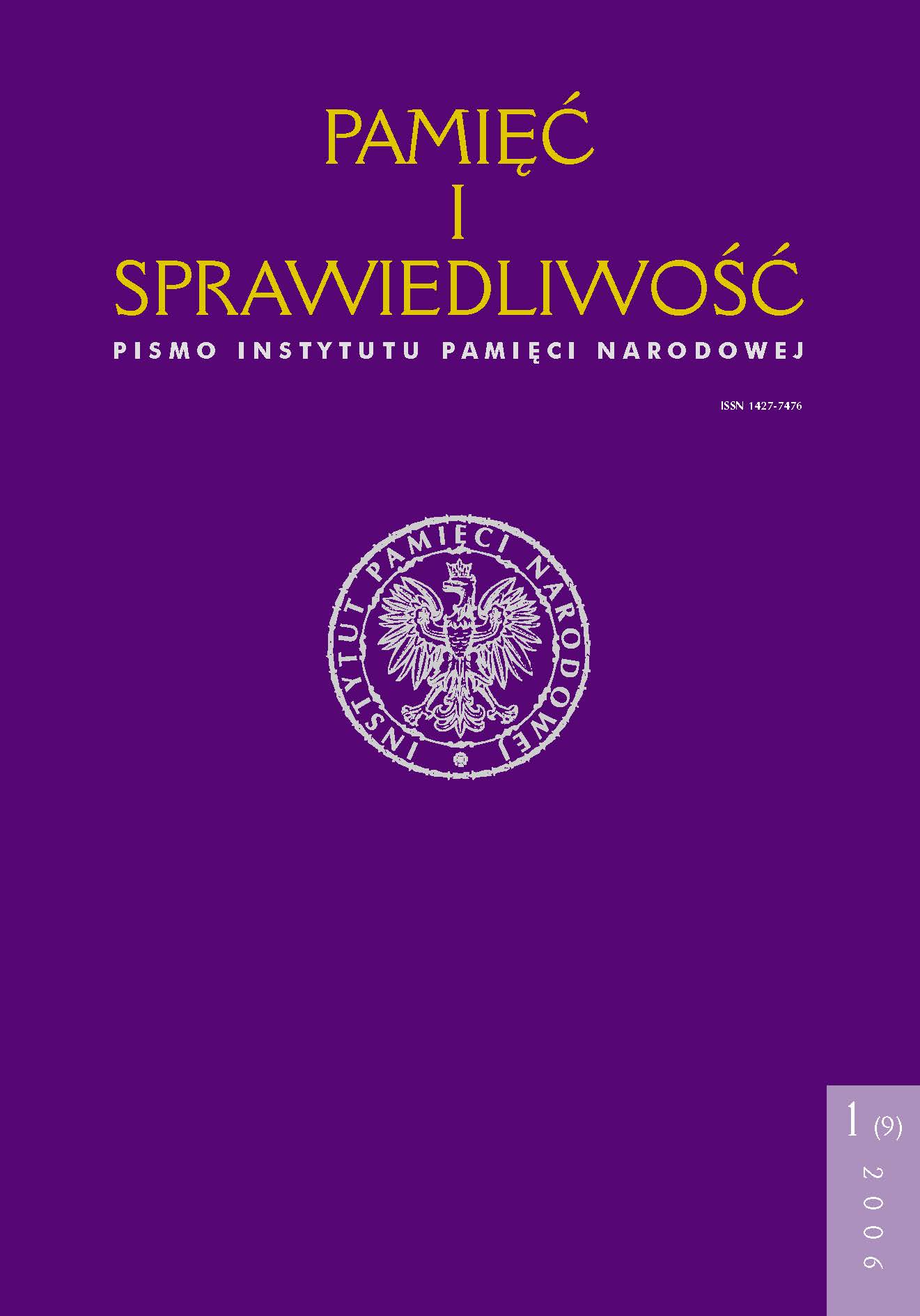Służba Bezpeky OUN-B (Służba Bezpieczeństwa OUN-B). Z warsztatów badawczych
Pamięć i Sprawiedliwość, Vol. 9 No 1 (2006), pages: 255-264
Publication date: 2006-06-30
Résumé
The Ukrainian resistance security police established in 1940 by S. Bandera and S. Łenkawskyj performed the role of a secret service and counter intelligence agency within Bandera’s faction of the Organisation of Ukrainian Nationalists (OUN). The first security police was commander was M. ¸ebed. From March 1941 he was replaced by M.Arsenych.
The hierarchy of the service was closely connected with the hierarchy of OUN. Besides the leadership centre, there were also local departments consisting of two sections: information gathering and investigations. Fighting squads of the security police, which among others arrested people and executed death penalty were reporting to the department empoloyees of each level. Security police members were the most reliable members of OUN.
The investigation conducted by OUN security police was merciless. What are known as third degree methods, i.e. torture, was used. In the case of minor offences, security police members thrashed suspects with beech sticks. People sentenced to death were shot or hanged. There were also cases of brutal murders.
Between 1943 and 1945 OUN security police took an active part in the slaughter of Polish people. In the years 1945–1948, those Poles who collaborated with the communist government or were actively opposed to the Ukrainian resistance were executed. In
practice, executions of Poles were not just limited to those two groups.
OUN security police applied the principle of collective responsibility (i.e. killing entire families). At the same time, Ukrainians suspected of collaboration with the communists
were also executed. The orders to apply solely the principle of personal responsibility were not given until May 1945. However, entire families were massacred beyond that date. Local OUN security police department employees were entitled to order the execution of a person. They enjoyed practically unlimited prerogatives. As a result, investigations were often brief and resistance members were executed in spite of unsubstantiated charges. The Soviets took advantage of the situation by staging numerous provocations, the result of which was the death of many OUN members wrongly accused of cooperation with the
communist security police.
OUN security police was law unto itself. The power of the OUN security police chief M. Arsenych (until his death in January 1947) was almost equal to the power of the leader of the Ukrainian National Insurgent Army (UPA). Separate departments of OUN security police survived until 1951 when most of the remaining members of this organisation took over positions as leaders of the OUN underground.
The activities of OUN security police stirred a lot of controversy among Ukrainian researchers. On the one hand, they emphasize that the collective responsibility used by the OUN security police OUN discouraged local people from supporting the underground, but on the other they regard the liquidation of communist agents as legitimate.
Articles les plus lus par le même auteur ou la même autrice
- Aleksandr Gogun, Anatolij Kentij, Grzegorz Motyka, Anna Madej, [Recenzja] Grzegorz Motyka, Ukraińska partyzantka 1942–1960. Działalność Organizacji Ukraińskich Nacjonalistów i Ukraińskiej Powstańczej Armii, Rytm, Warszawa 2006, ss. 720 , Pamięć i Sprawiedliwość: Vol. 12 No 1 (2008)
- Paweł Machcewicz, Grzegorz Motyka, [Recenzja] W odpowiedzi Frankowi Grelce , Pamięć i Sprawiedliwość: Vol. 6 No 2 (2004)
- Piotr Madajczyk, Grzegorz Motyka, Bogdan Musiał, Bożena Szaynok, Eugeniusz Mironowicz, [Dyskusja] Problemy narodowościowe na ziemiach polskich w latach 1939–1989 , Pamięć i Sprawiedliwość: Vol. 6 No 2 (2004)
- Grzegorz Motyka, Nie tylko likwidacja prowidnyka „Stiaha”. Działania grupy operacyjnej „Lubaczów” w 1947 r. , Pamięć i Sprawiedliwość: Vol. 37 No 1 (2021)
- Wasyl Szpicer, Grzegorz Motyka, [Recenzja] Wasyl Szpicer, Wołodymyr Moroz, Krajowyj Prowidnyk Wołodymyr Tymczij – „Łopatynśkyj”, Wydawnictwo „Afisza”, Lwiw 2004, ss. 256 , Pamięć i Sprawiedliwość: Vol. 10 No 2 (2006)
- Grzegorz Motyka, Iwan Patrylak, [Recenzja] Ukraiński ruch wyzwoleńczy w oczach polskiego badacza (recenzja książki Grzegorza Motyki, Ukraińska partyzantka 1942–1960, Warszawa 2006, 720 s.) , Pamięć i Sprawiedliwość: Vol. 13 No 2 (2008)
- Grzegorz Motyka, Dywizja SS „Galizien” („Hałyczyna”) , Pamięć i Sprawiedliwość: Vol. 1 No 1 (2002)
- Grzegorz Motyka, Kolaboracja na Kresachm Wschodnich II Rzeczypospolitej 1941–1944 , Pamięć i Sprawiedliwość: Vol. 12 No 1 (2008)
- Grzegorz Motyka, Jeszcze o stosunku Polaków do sowieckich partyzantów – byłych jeńców , Pamięć i Sprawiedliwość: Vol. 11 No 1 (2007)
 Język Polski
Język Polski
 English
English
 Deutsch
Deutsch
 Français (France)
Français (France)
 Italiano
Italiano
 Русский
Русский


 PDF (Język Polski)
PDF (Język Polski)
